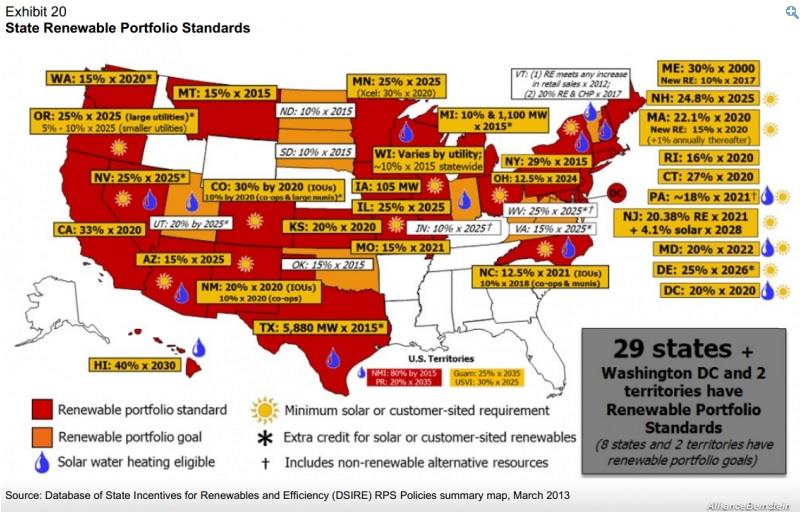According to the National Academy of Engineering, the electrification of America was the greatest engineering achievement of the 20th century.
Over the last 140 years, the US electrical grid has been cobbled together in a piecemeal, haphazard fashion. For example, today the system consists of:
- 3,000 public, private, and co-op utilities
- 1,000 independent power generators
- three regionally synchronized grids
- eight reliability councils
- 150 control-area operators
- thousands of local, state, and federal regulatory institutions
75% of US power is generated by investor-owned utilities and according to the US Energy Information Administration (EIA), as of 2013 the sources of US electricity were: coal (50%), gas (20%), nuclear (17.2%), hydroelectric (10.3%), and non-hydro renewable (1.3%).
This heavy use of coal represents a major problem with the current US electrical system and is why modern regulatory and environmental pressures threaten America's economic future.
History of a crisis
Between 1900 and the 1960's electric utilities faced steadily rising demand, friendly regulatory conditions, improving technologies, and economies of scale.
Between 1900 and the 1960's electric utilities faced steadily rising demand, friendly regulatory conditions, improving technologies, and economies of scale.
However, starting in the late 60's and into the 1970's new environmental regulations and two oil shocks resulted in sharp increases in energy costs, prompting a call for change and deregulation.
Deregulation represented a breaking of the traditional monopoly most electrical utilities operated under and today 29 states operate offer some form of a deregulated energy model, which allows customers to purchase power from third party power generators.
Threats to the electric utilities
There are three primary threats that modern electrical utilities must deal with. First is America's decrepit energy infrastructure, which the American Society of Civil Engineers (ASCE) gives a grade of D+. This poor grade is due to massive under-investment in the nation's power grid, which the ASCE estimates will result in an investment gap of $94.7 billion by 2020.
Electricity demand is expected to increase 8%-9% through 2020, and utilities are expected to add 10% capacity through 2016, mostly from cleaner gas and renewable sources. However, according to the EIA, by 2025 the average age of a coal-fired power plant will be 49 years with 20% of coal plants being 60+ years old. As older and dirtier plants are retired, America's excess energy capacity will decline to dangerously low levels, threatening blackouts, and major economic disruption (it costs the average business $1,000/hour during a blackout).
Which brings me to the second major threat to the traditional electrical utility industry: stricter regulations. For example, to modernize America's infrastructure, 17,000 miles of high-power transmission lines are needed over the next five years, which is about triple the historical five-year construction rate. However, many of those projects face regulatory challenges, including "not in my backyard" NIMBYism, that threaten to cause delays, cost overruns, or outright cancellations.
In addition to permitting challenges, utilities are faced with the Obama Administration's new Clean Power Plan announced on June 2, which aims to cut CO2 emissions by 2030, mainly though the use of high efficiency gas and renewable energy.
Many states are also establishing renewable portfolio standards, (RPS) in which a certain percentage of a state's power must come from renewable power. These RPS requirements can add as much as 3.75% in incremental costs that utilities must incur. Currently, 29 states and DC have these standards, which can be as high as 33% in California and 40% in Hawaii.

Which brings me to the third and potentially largest threat to traditional electrical utilities -- competition from distributed solar power.
Companies such as SolarCity are growing like a weed by offering residents in 15 states
no up-front cost solar leases. In exchange for a 20-year lease, customers save 10%-15% in monthly energy bills while the company installs and operates a solar system on their home.

Source: SolarCity.com
Hope for the future
A national smart grid would use computers to optimize the integration of renewable energy into America's electrical generating portfolio and allow for a transition to electric cars. EV battery packs could be a large-scale source of energy storage for intermittent solar and wind power, and analysts estimate that each dollar invested in a smart grid would provide $2.8-$6 in benefits to the economy.
Foolish takeaway
Electrical utilities make up one of America's oldest industries. However, new regulatory and environmental risks mean the industry must embrace renewable energy and smart grid technology to flourish and allow America to remain economically competitive during the coming century.
Electrical utilities make up one of America's oldest industries. However, new regulatory and environmental risks mean the industry must embrace renewable energy and smart grid technology to flourish and allow America to remain economically competitive during the coming century.